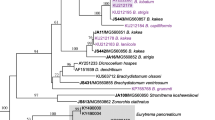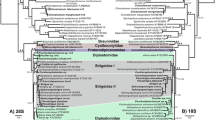Abstract
A phylogenetic study of two parasites found on the common host species Gracilaria salicornia from Japan and Malaysia based on nuclear, plastid, and mitochondrial molecular markers was conducted. The Japanese and Malaysian parasites were placed in the same cluster in the nuclear phylogenies inferred from the LSU rRNA gene and ITS region, supporting the monophyly of these parasites despite the slight anatomical variations observed. In addition to the molecular analyses, shared morphological and reproductive features including the lack of rhizoids, similar coloration to hosts, and the presence of deep spermatangial conceptacles supported the inclusion of both the Japanese and Malaysian parasites in Congracilaria babae. Phylogenetic analyses based on ITS sequences indicated that C. babae most likely evolved directly from its current host species, G. salicornia. C. babae was shown to be a member of Gracilaria sensu stricto along with its host. C. babae growing on G. salicornia is characterized by having plastid rbcL and mitochondrial cox1 gene sequences identical to those of its host, whereas the nuclear LSU rRNA gene and ITS region sequences are different from those of its host.




Similar content being viewed by others
References
Ashen JB, Goff LJ (2000) Molecular and ecological evidence for species specificity and coevolution in a group of marine algal-bacterial symbioses. Appl Environ Microbiol 6:3024–3030
Bellorin AM, Oliveira MC, Oliveira EC (2002) Phylogeny and systematic of the marine algal family Gracilariaceae (Gracilariales, Rhodophyta) based on small subunit rDNA and ITS sequences of Atlantic and Pacific species. J Phycol 38:551–563
Farr ER, Leussink JA, Stafleu FA (1979) Index nominum genericorum (Plantarum). 3 vols. Bohn, Scheltema and Holkema, Utrecht (Regnum Vegetabile vol. 100–102), pp 1896
Feldmann J, Feldmann G (1958) Recherches sur quelques floridées parasites. Rev Gén Bot 65:49–128
Fredericq S, Hommersand MH (1990a) Diagnoses and key to the genera of the Gracilariaceae (Gracilariales, Rhodophyta). Hydrobiologia 204/205:173–178
Fredericq S, Hommersand MH (1990b) Morphology and systematics of Holmsella pachyderma (Pterocladiophilaceae, Gracilariales). Brit Phycol J 25:39–51
Fredericq S, Hommersand MH, Norris JN (1989) Morphological observations on the adelphoparasite Gracilariophila oryzoides (Gracilariales, Rhodophyta). Jpn J Phycol 37:167–179
Freshwater DW, Rueness J (1994) Phylogenetic relationships of some European Gelidium (Gelidiales, Rhodophyta) species, based on rbcL nucleotide sequence analysis. Phycologia 33:187–194
Gavio B, Fredericq S (2002) Grateloupia turuturu (Halymeniaceae, Rhodophyta) is the correct name of the non-native species in the Atlantic known as Grateloupia doryphora. Eur J Phycol 37:349–359
Geraldino PJL, Yang EC, Boo SM (2006) Morphology and molecular phylogeny of Hypnea flexicaulis (Gigartinales, Rhodophyta) from Korea. Algae 21:417–423
Gerung SG, Yamamoto H (2002) The taxonomy of parasitic genera growing on Gracilaria (Rhodophyta, Gracilariaceae). In: Abbott IA, Mcdermid KJ (eds) Taxonomy of Economic Seaweeds with reference to some Pacific species vol. VIII. California Sea Grant College Program, La Jolla, pp 209–213
Gerung GS, Terada R, Yamamoto H, Ohno M (1999) An adelphoparasite growing on Gracilaria edulis (Gracilariaceae, Rhodophyta) from Manado, Indonesia. In: Abbott IA (ed) Taxonomy of Economic seaweeds with reference to some Pacific species vol. VII. California Sea Grant College Program, La Jolla, pp 131–136
Goff LJ, Coleman AW (1987) Nuclear transfer from parasite to host: a new regulatory mechanism of parasitism. Ann NY Acad Sci 503:402–423
Goff LJ, Coleman AW (1995) The fate of parasite and host organelle DNA during cellular transformation of red algae by their parasites. Plant Cell 7:1899–1911
Goff LJ, Moon DA, Coleman AW (1994) Molecular delineation of species and species relationships in the red algal agarophytes Gracilariopsis and Gracilaria (Gracilariales). J Phycol 30:521–537
Goff LJ, Moon DA, Nyvall P, Stache B, Mangin K, Zuccarello G (1996) The evolution of parasitism in the red algae: molecular comparisons of adelphoparasites and their hosts. J Phycol 32:297–312
Goff LJ, Ashen J, Moon D (1997) The evolution of parasites from their hosts: a case study in the parasitic red algae. Evolution 51:1068–1078
Guiry MD (1978) The importance of sporangia in the classification of the Florideophyceae. In: Irvine DEG, Price JH (eds) Modern approaches to the taxonomy of red and brown algae. Academic Press, London, pp 111–114
Gurgel CFD, Fredericq S (2004) Systematics of the Gracilariaceae (Gracilariales, Rhodophyta): a critical assessment based on rbcL sequence analyses. J Phycol 40:138–159
Hall TA (1999) BioEdit: a user-friendly biological sequence alignment editor and analysis program for Windows 95/98/NT. Nucl Acid S 41:95–98
Huelsenbeck JP, Ronquist F (2001) MRBAYES: bayesian inference of phylogenetic trees. Bioinformatics 17:754–755
Johansen DA (1940) Plant microtechnique. McGraw-Hill, New York, p 523
Kongkittayapun N, Chirapart A (2011) Morphometric and molecular analysis of Gracilaria salicornia and its adelphoparasite in Thailand. ScienceAsia 37:6–16
Kurihara A, Abe T, Tani M, Sherwood AR (2010) Molecular phylogeny and evolution of red algal parasites: a case study of Benzaitenia, Janczewskia and Ululania (Ceramiales). J Phycol 46:580–590
Le Gall L, Dalen JL, Saunders GW (2008) Phylogenetic analyses of the red algal order Rhodymeniales supports recognition of the Hymenocladiaceae fam. nov. Fryeellaceae fam. nov., and Neogastroclonium gen. nov. J Phycol 44:1556–1571
Posada D, Crandall KA (1998) MODELTEST: testing the model of DNA substitution. Bioinformatics 14:817–818
Rambaut A, Drummond AJ (2009) Tracer v1.5, Available free from http://beast.bio.ed.ac.uk/Tracer
Robba L, Russell SJ, Barker GL, Brodie J (2006) Assessing the use of the mitochondrial cox1 marker for use in DNA barcoding of red algae (Rhodophyta). Am J Bot 93:1101–1108
Saunders GW (2005) Applying DNA barcoding to red macroalgae: a preliminary appraisal holds promise for future applications. Philos T R Soc B 360:1879–1888
Schneider CW, Wynne MJ (2007) A synoptic review of the classification of red algal genera a half century after Kylin’s ‘Die Gattungen der Rhodophyceen”. Bot Mar 50:197–249
Sherwood AR, Kurihara A, Conklin KY, Sauvage T, Presting GG (2010) The Hawaiian Rhodophyta Biodiversity Survey (2006–2010): a summary of principal findings. BMC Plant Biol 10:258–287
Sturch HH (1926) Choreocolax polysiphoniae Reinsch. Ann Bot 40:585–605
Swofford DL (2002) PAUP*: Phylogenetic Analysis Using Parsimony (*and other methods). Sinauer Associates, Sunderland
Tanabe AS (2007) KAKUSAN: a computer program to automate the selection of a nucleotide substitution model and the configuration of a mixed model on multilocus data. Mol Ecol Notes 7:962–964
Terada R, Yamamoto H, Maraoka D (1999) Observations on an adelphoparasite growing on Gracilaria salicornia from Thailand. In: Abbott IA (ed) Taxonomy of Economic seaweeds with reference to some Pacific species vol. VII. California Sea Grant College Program, La Jolla, pp 121–130
Thompson JD, Gibson TJ, Plewniak F, Jeanmougin F, Higgins DG (1997) The ClustalX windows interface: flexible strategies for multiple sequence alignment aided by quality analysis tools. Nucleic Acids Res 24:4876–4882
Weber-van Bosse A (1928) Liste des algues du Siboga. IV. Rhodophyceae, troisieme partie: Gigartinales et Rhodymeniales. Siboga-Expeditie Monographie, E. J. Brill, Leiden, pp 393–533
Wilson HL (1910) Gracilariophila, a new parasite on Gracilaria confervoides. Univ Calif Publ Bot 4:75–84
Yamamoto H (1986) Congracilaria babae gen. et sp. nov. (Gracilariaceae), an adelphoparasite growing on Gracilaria salicornia of Japan. Bull Fac Fish Hokkaido Univ 37:281–290
Yamamoto H (1991) Observation on the adelphoparasite Congracilaria babae Yamamoto (Gracilariaceae, Rhodophyta) of the Philippines. Jpn J Phycol 39:381–384
Yamamoto H, Phang SM (1997) An adelphoparasitic alga growing on Gracilaria salicornia from Malaysia. In: Abbott IA (ed) Taxonomy of Economic Seaweeds with reference to some Pacific and Caribbean species vol. VI. California Sea Grant College Program, La Jolla, pp 91–96
Yang EC, Kim MS, Geraldino PJL, Sahoo D, Shin JA, Boo SM (2008) Mitochondrial cox1 and plastid rbcL genes of Gracilaria vermiculophylla (Gracilariaceae, Rhodophyta). J Appl Phycol 20:161–168
Yow YY, Lim PE, Phang SM (2011) Genetic diversity of Gracilaria changii (Gracilariaceae, Rhodophyta) from west coast, Peninsular Malaysia based on mitochondrial cox1 gene analysis. J Appl Phycol 23:219–226
Zuccarello GC, West JA (2006) Molecular phylogeny of the subfamily Bostrychioideae (Ceramiales, Rhodophyta): subsuming Stictosiphonia and highlighting polyphyly in species of Bostrychia. Phycologia 45:24–36
Zuccarello GC, West JA (2011) Insights into evolution and speciation in the red alga Bostrychia: 15 years of research. Algae 26:21–32
Zuccarello GC, Moon D, Goff LJ (2004) A phylogenetic study of parasitic genera placed in the family Choreocolacaceae (Rhodophyta). J Phycol 40:937–945
Acknowledgments
We are grateful to Madam Patricia Loh for the technical assistance in preparing sections of tissue using paraffin method. This study was funded in part by the Postgraduate Research Fund from University of Malaya (PS275/2009C and PV082/2011B), Fundamental Research Grant Scheme (FP033-2012A) and MoHE-HIR grant (H-50001-00-A000025) from the Ministry of Higher Education (MOHE), Malaysia and a grant awarded by the Malaysia Toray Science Foundation (MTSF1052-2010).
Author information
Authors and Affiliations
Corresponding author
Rights and permissions
About this article
Cite this article
Ng, PK., Lim, PE., Kato, A. et al. Molecular evidence confirms the parasite Congracilaria babae (Gracilariaceae, Rhodophyta) from Malaysia. J Appl Phycol 26, 1287–1300 (2014). https://doi.org/10.1007/s10811-013-0166-5
Received:
Revised:
Accepted:
Published:
Issue Date:
DOI: https://doi.org/10.1007/s10811-013-0166-5




